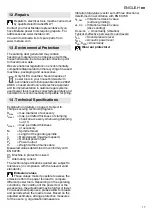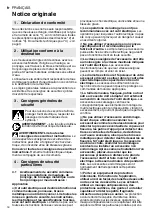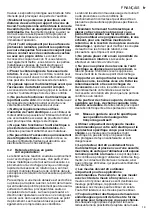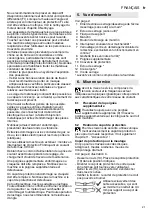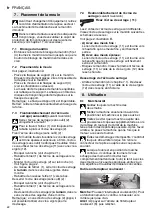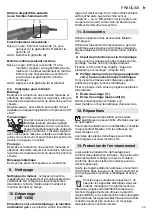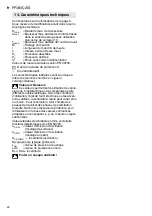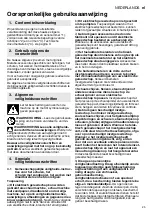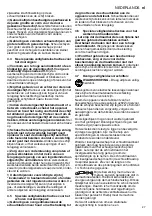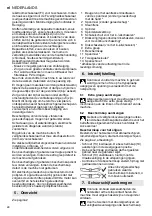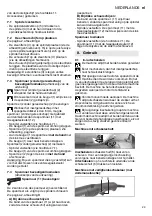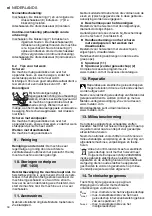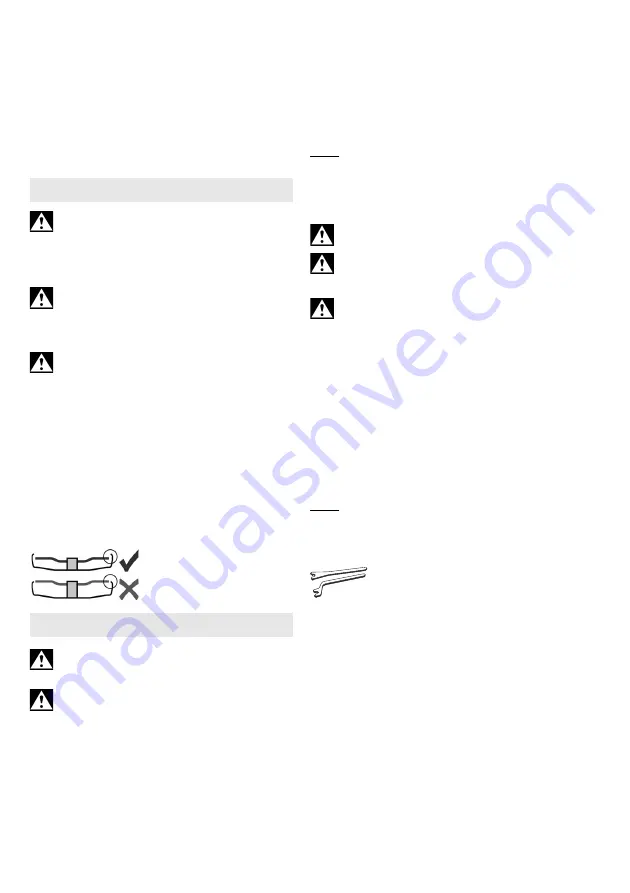
ENGLISH
en
15
7 Lock (to prevent the machine from being switched
on unintentionally, or for continuous operation) *
8 Trigger ( for switching on and off) *
9 Additional handle
10 Safety cover
11 Clamping nut *
12 2-hole spanner *
13 Clamping screw
* depending on equipment/not in scope of delivery
Before plugging in, check to see that the rated
mains voltage and mains frequency,
as stated on the rating label, match your power
supply.
6.1 Attaching the additional handle
Always work with the additional handle
attached (9)! Attach the additional handle
on the left or right of the machine and secure.
6.2 Install safety guard
For safety reasons, always use the safety
guard provided for the respective wheel! See
also chapter 11.
Safety guard for grinding
Designed for work with roughing wheels, flap
sanding pads, diamond cut-off wheels.
See page 2, illustration C.
- Slacken the screw (13). Place the safety guard
(10) in the position indicated.
- Turn the safety guard until the closed section is
facing the operator.
- Tighten the screw (13), ensuring that the anti-twist
device engages in the slots.
- Make sure that the guard is seated securely: you
should not be able to turn the safety guard.
Use only accessories that
are covered by at least
3.4 mm by the safety guard.
Disconnect the mains plug before changing
any accessories. The machine must be
switched off and the spindle at a standstill.
For reasons of safety, attach the parting guard
before performing parting work
(see chapter 11. Accessories).
7.1 Locking the spindle
- Press in the spindle locking button (5) and turn the
spindle (4) by hand until the spindle locking button
engages.
7.2 Placing the grinding wheel in position
See page 2, illustration A.
- Place the supporting flange (3) on the spindle (see
illustration above). The flange should not turn on
the spindle when properly attached.
- Place the grinding wheel on the
support flange (3) (see illustration above).
The grinding wheel must lay flat on the supporting
flange. The metal flange on the parting grinder
disc must lay flat on the support flange.
Note: The support flange (3) is secured to prevent it
from falling off. To remove: use some force if
necessary.
7.3 Securing/releasing the (tool-free)
clamping nut
(depending on features)
Only tighten the (tool-free) clamping nut (2)
manually.
For the machine to operate, the clip (1) must
always lie flat on clamping nut (2) .
To secure the (tool-free) clamping nut (2):
Do not use the (tool-free) clamping nut if the
accessory has a clamping shank thicker than 6
mm! In this case, use the clamping nut (11) with 2-
hole spanner (12).
- Lock the spindle (see chapter 7.1).
- Flip up the clip (1) on the clamping nut.
- Fit the clamping nut (2) on the spindle (4). See
illustration on page 2.
- (1)Tighten the clamping nut
on the clip manually
in a clockwise direction.
- Flip down the clip (1) again .
To release the (tool-free) clamping nut (2) :
- Lock the spindle (see chapter 7.1).
- Flip up the clip (1) on the clamping nut.
- Unscrew the clamping nut (2) , turning it
anticlockwise
manually
.
Note: If the clamping nut is very tightly secured (2),
you can also use a 2-hole spanner to unscrew it.
7.4 Securing/releasing the clamping nut
(depending on features)
Securing the clamping nut (11):
The 2 sides of the clamping nut are different. Screw
the clamping nut onto the spindle as follows:
See page 2, illustration B.
-
A) For thin grinding wheels:
The edge of the clamping nut (11) faces upwards
so that the thin grinding wheel can be attached
securely.
B) For thick grinding wheels:
The edge of the clamping nut (11) faces
downwards so that the clamping nut can be
attached securely to the spindle.
- Lock the spindle. Turn the clamping nut (11)
clockwise using the 2-hole spanner (12) to
secure.
Releasing the clamping nut:
- Lock the spindle (see chapter 7.1). Turn the
clamping nut (11) anticlockwise using the 2-hole
6. Commissioning
7. Attaching the grinding wheel

















